
Don't worry, you can get your benefits reinstated. Start with an email, as I explain below.
Keep in mind, most people only need to submit this form every other year. (See submittal requirements below)
Do you receive benefits from the US Social Security Administration (SSA)? Then you were required to submit a Proof of Life form in 2016, if you meet any of the conditions below:
(note: If your SSN ends in 50 -99, you must submit the "Proof of Life" form in 2017, not 2016)
In May/June of each year these forms are sent to the mailing address you have on record with the SSA. A second request is mailed in October.
This is why it is important to keep your address updated with SSA.
If you were required to submit your proof of life form to SSA in 2016 but haven't, you should e-mail the Federal Benefits at [email protected] .
Ask for them to email you a "Proof of Life" form and instructions on how to get your benefits reinstated.
More Information
I have written more extensively on the required SSA Proof of Life form in a previous post.
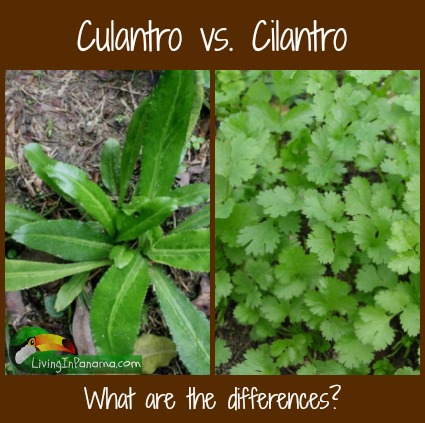
Culantro is used extensively in Panamanian food.
It is easy to find culantro in Panama, cilantro is harder to find.
I can almost always find culantro growing wild in small patches in my yard. It grows in both shade and sun. Sometimes they also sell it in the market and, I've recently been told, you can also sometimes find dried culantro in grocery stores here.
If you are looking for it in the US, Canada, or Europe, you may be able to find it in Asian or Hispanic markets (especially Vietnamese, Thai, Puerto Rican or Dominican Republic markets).
If you want to use cilantro in Panama, your best bet is to grow it yourself. Although, as you will read below, that is not an easy task.
Worldwide, culantro is known by many names: recao, long coriander, ngo-gai, spiritweed, black benny, recao de monte, false coriander, spiny coriander, among others.
Leaves
Cilantro leaves are small and lacy like parsley leaves.
Cilantro leaves grow on stems that are several inches above the ground.
Culantro leaves are long and spiny like dandelion leaves. It's leaves are also much tougher than cilantro leaves. They can grow up to 10 inches long.
Culantro leaves grow in whorls that form at the base of the plant.
Flowers & Propagation
Culantro's flower stalks also have spines. The spines on both the leaves and the stalks become quite sharp as the plant matures. The flower blooms at the top of what looks like a green straw.
This flower will produce seeds. These seed can be used to grow new plants, although, in Panama culantro is self-seeding. It can also be grown from cuttings. Culantro can grow in poor soil with little fertilizer. They are hardy, prefer partial shade, but tolerate full sun.
Cilantro flowers are white and lace-like on a long stem.
Cilantro is not a hardy plant, especially in the tropics. Cilantro is particularly hard to grow in the tropics since it doesn't love heat, but needs to grow in full sun. Cilantro can only be grown here in the cooler months. (For more on Panama climate)
Harvesting
I send my girls out to pick some culantro leaves when I need them. But if you lack children, you can pinch off or cut the leaves at the soil line with scissors.
Leave the newer leaves for use in future meals. Be careful of the spines when gathering the leaves.
Differences in Use
Because culantro has a much stronger flavor, it is usually added during the cooking process. If you want to put it in a salad, cut it into thin ribbons; otherwise use cilantro.
Culantro is a common ingredient in food in Panama. For instance, it is typically one of the main ingredients in a guiso (or sofrito), an aromatic blend of herbs and spices used to flavor many beans, fish, meats, rice and stew dishes.
Guiso. There are a lot of variations of guiso (also know as sofrito throughout latin america). In Panama it is usually called guiso and often consists of a blend of culantro leaves, onion, garlic, fresh tomatoes, and sometimes non-spicy small peppers . Conveniently, you can make it in advance and refrigerate or freeze it for later use.
Cilantro is more likely to be eaten raw in ceviche, salsas or as a garnish.
If you are going to live in Panama, culantro is a herb you will learn to love. Unless, you are like my younger daughter and detest anything that even hints at the taste of cilantro.
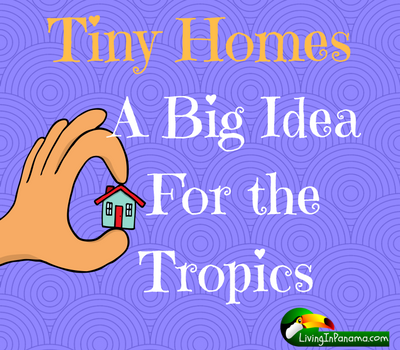
Ascetic monks from the 15th century and earlier have written about the spiritual benefits of casting off the extraneous luxuries of society and getting back to the bare necessities of life.
The ascetics felt that only without encumbrances and distractions is man truly able to achieve spiritual grounding. Only by practicing simple daily rituals can one enjoy a meaningful life.
Henry David Thoreau got back to basics at Walden Pond in Massachusetts in the 19th century and wrote extensively about the beauty and spirituality that filled his days. Thoreau was quite outspoken in his criticism of common “city dwellers” who were distracted by too much of everything. Of course, Thoreau who lived in the 1800s had no way to imagine the distractions that man would face by 2016. My wife Betsy is quick to point out that Thoreau was a frequent visitor of his mother’s home around mealtime, and that he sent his laundry out to be washed. (I guess it’s tough to be a perfect ascetic).
The early 19th century Irish Poet and academic William Butler Yeats spent many hours “living alone in a Bee loud Glade” in a tiny cottage on the Lake Isle of Innisfree in County Sligo. Many of his poems are situated at this, or other “sacred” natural places. Yet, he also taught writing at University in Sligo, and had a very complex life as a university administrator, husband, father, and community member. For Yeats, a simple thatch hut was a respite from the stresses of day to day living.
The current revival of the small, or “tiny” houses can be attributed in large part to the vast popularity of architect/writer Susan Susanka’s 1998 book “the Not-so-Big-House”. In her book, Susanka asks the basic question of “why does it need to be so big?”
After all, the average size of the North American family has been shrinking since World War II. Yet our houses have been steadily growing. In 1950, the average US home was 1000 square feet. In 1960, it had grown to 1200 square feet. By 1990 it was 2000 square feet. In 2016 the average new home built in the US was just over 2,400 square feet. The only nation in the world with larger homes is Australia where the average sized home built in 2016 was 2,500 square feet.
How did we evolve from a family of four in the 1960’s that fit into a 1200 square foot home, to a family of 2.5 that requires twice as much room? Are we happier now that we have all this room?
Most studies show that the overwhelming reason for the “super-sizing” of North American home has mostly to do with our ability to afford it. Simply put, North Americans have a lot more money than we had back in 1960. In a market driven society, all that money needs to be spent on something. Why not buy a bigger house?
The modern day iteration of the truly “tiny” house evolved from this rethinking of house size that followed on the heels of Susan Susanka’s best selling book. In fact, these days we even try to define what the limits are for each category of small house.
As I mentioned in a previous article, I have lived in a shipping container in Alaska for 2 summers. At 8’x40’ the 320 square foot container was the perfect “tiny man cave” for warming up and sleeping after a long, long day of commercial fishing. However, I would not consider this amount of space (especially the 8’ ceiling height which felt really low) to be a space that I would have appreciated in any other context.
Even my 262 square foot studio apartment in Seattle’s University District where I lived during graduate school, was much a more pleasant space.
This apartment had been carved out of the second floor hallway and a corner room of a hundred year old craftsman house. It had huge windows, and nearly 10’ ceilings. It was much smaller, but it was a perfect city apartment for a busy student on a budget. An added bonus was that my landlord really didn’t care what I did to my unit, as long as I asked first. So, I cut an interior opening between the kitchen and the bedroom to get a view and some daylight into the kitchen/desk alcove. I also installed a new shower and tiled the bathroom.
Rising Interest In Tiny Homes
With the insane rise in home prices in Seattle, and other similar cities, many people, especially the young and retirees on a budget are revisiting the Tiny home concept in order to continue living in the cities which they have come to love and appreciate. Not everyone has an extra $2000 to be able to rent a studio apartment. Many do not want to move out to the suburbs and spend their day commuting to and from the city.
There is a loophole in the maximum housing density law in Seattle which allows Tiny homes to be located on residential property, provided that the home is equipped with functional tires and a trailer hitch. In other words, these “homes” must fit on the roadway and be moved from the property from time to time (I am not sure how often). In other words, the Tiny homes allowed in Seattle are really more like wood framed trailers. As such, the sizes are quite standardized, in order to conform with the building codes as well as the transportation codes. Being so standardized is, from a design standpoint, pretty boring. Most Tiny Homes tend to look alike, sort of “cookie cutter” versions of one another, just with different window treatments, siding materials, and of course, interior finishes. However, the good news about this standardization of size and form is that these tiny houses can be factory built and delivered to your home site pretty much anywhere in the US.
We have had a few inquiries in recent months from folks who already live in Boquete, or in other highland areas of Chiriqui who are curious about what it would take for them to park a trailer, or mobile home on an affordable lot on or near the beach, to use for long weekends, so that they could get their “beach fix” without the having to stay in a hotel.
To my mind, the tiny house concept might be the perfect solution for those who just want a semi-permanent “camp” at the beach that is always waiting for them. I have not priced shipping containers lately, but I think that a shipping container base/secure storage locker could be used as the construction locker/storage unit for beach chairs, bar-b-q, surf boards, etc…so that there would be no risk of break-in in the event that one didn’t have anyone watching the property.
The tiny house, as a short-term accommodation is also a natural rental unit. Many short-term guests to the beach don’t have much luggage, no possessions, and they don’t need much space. Rentals in Puerto are still tough to find. As such, rental rates in Puerto are high. I think it is just a matter of time before some enterprising builder begins to produce tiny homes as rental houses. We have had a couple of calls from guys who have experience building pre-fab homes and tiny homes, already. It is not out of the question that we, ourselves, may build a tiny home or two on one of our properties, so that our clients will have a pleasant place to live while they explore Puerto Armuelles.
Our Ideal Tiny Home Is Bigger
After all our recent researches of tiny homes, Betsy and I are drawing the same conclusion that many others have arrived at before us. That is, Tiny Homes could be just the ticket as a weekend retreat, or a short-term rental. Tiny Homes seem like an amazing business opportunity.
However, when I consider designing a retirement home for my wife Betsy and myself, a small house feels better than a tiny one. I know that I would breathe a little freer in a slightly bigger space than the sub-400 square foot size which defines the truly “tiny” house.
If I had to throw out a number, my own personal ideal size dwelling for a single person would probably fall in the 600-800 square foot range. For a couple, I would think 800-1200 square feet would do well. This allows room for one to be alone for awhile to study, meditate, or practice a musical instrument, without disturbing one’s partner.
Living In Panama House
The Living in Panama House is probably not the final and “perfect” solution to the idea of living a big lifestyle in a small house in the tropics. However, it is the best that I have been able to come up with so far. Believe me, I have given this a lot of thought. I consider the Living in Panama House to represent an honest attempt at a “Not So Big Tropical House”.
As we have been refining the Living in Panama House design, our model has grown a bit, and shrunk a bit. But we keep coming back to about 500 square feet of finished, potentially air conditioned space. This “module which contains the two bedrooms, bath, and a small hallway, is all housed within the “umbrella” of a big sheltering roof. The three-bedroom model is about 650 square feet enclosed. The total square footage of the first model home (two or three bedrooms) is approximately 1,500 square feet.
The Living in Panama house is a bit bigger than my ideal house size for North America, because we think that it is beneficial to have a bit more covered space in the tropics to allow one to enjoy an open, breezy feeling, since it can get hot here. Also, we have more “hang out” time in Puerto Armuelles than we have in Seattle where one just doesn’t have much time to enjoy being at home. So, we end up using our house more here. Betsy and I will undoubtedly adjust the size of the Living in Panama House up or down over time, depending upon feedback we get from clients.
Tiny Home Builders Wanted
If you have any interest in building tiny homes in Puerto Armuelles, we would be happy to help you get started. Drop us a line. There is certainly room for competition in our untapped housing market.
Jan 1, 2017
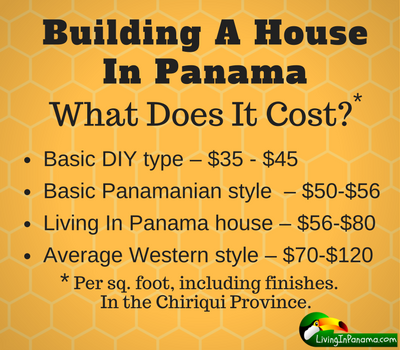
“How much does it cost/square foot to build a house in Puerto Armuelles?”
The answer depends upon what kind, size, and quality of house you are building.
If you build a fancy house, with lots of expensive materials (expensive windows, doors, custom fixtures, etc.) it will cost a lot more than a very basic house. It won’t cost just 10%, or 20% more. Building a fancy house can cost 2 to 10 times more than a very basic house.
In Seattle, circa 2016, building a basic house costs about $200 per square foot. A house with expensive finishes can cost $250 to $500 per square foot (I am not kidding). And it goes up from there. An architect-designed, custom timber-framed, Japanese tea house or fancy outdoor sauna building on the lake could cost over $1000 per square foot
In Puerto Armuelles the answer is the same: it depends upon what kind of house you are building.
Fancy Houses
On the high end, there are wealthy expats who have had homes built on the beach by local contractors. They can easily spend $100/sq ft and more. This does not include the cost of the land.
More Basic Houses
On the other hand, in Puerto Armuelles we have several expats who have been their own contractor and have also done a lot of the work themselves. These folks have completed their projects for under $35/sq ft. Granted some of these homes lack much of a design concept since the owner-builders had not built before. However, the owner/builders appear quite pleased with the results.
I have done a brief survey of costs recently. I took into account my conversations with builders and owners. (As I drive around the Chiriquí province, I often stop by construction sites to chat.) I have also done the usual online research that is available to all of us. Based on these sources, I have concluded the cost figures below.
Cost per Sq. Ft Range
As I read the descriptions of the different grades or qualities of construction available at the various price points, one thing is quite familiar. Just as in the US, the big difference in the cost of construction is in the finishes.
Finishes include:
The finishes vary greatly in price. The cost per square foot for the structure of the house does not vary nearly as much as it does for the finishes.
People understandably want to know how much it will cost to build a house in Panama.
The Living In Panama House has the advantage of being designed by an architect specifically for Panama's tropical climate.
The Living in Panama house is an entire “rethink” of the concept of “home” in the tropics. The Living In Panama house is mostly an open-air living concept. This open-air structure, with just a portion totally enclosed, means that only a small section of the house requires the full complement of finishes. With this type of design, you eliminate the need to pay for extra windows, doors, air conditioners, insulation, or cabinetry. Not that you don’t have those finishes, but fewer of them are needed.
Because of this savings, the Living in Panama House, can be built, including finishes, for between $56 and $80 per square foot. This is a huge saving.
The structure of the house, without finishes, costs an estimate of $30 per square foot for the 2 bedroom model and an estimate of $38 per square foot for the 3 bedroom model.
The cost of building anywhere in Panama varies. The biggest variable is your choice of finishes.
Summary of cost/square foot (including finishes)
I hope this helps to answer this popular question.
We have written about remodeling, various construction materials, and alternative housing types. Click on any of the links below to read an article.
Please share your experiences with the cost of building a house in Panama. Use the comment section below. Thank you.
[leadplayer_vid id="58506DB07FEED"]
If you are interested in visiting Mono Feliz, visit their facebook page for more information. I have also written about Mono Feliz on my site.
You can visit Mono Feliz via a road (which is soon to be paved most of the way) or, my favorite way, by driving on the beach. You must time your journey with the tides.
We have visited Mono Feliz from Puerto Armuelles both as a day trip and for multiple nights.
You can learn more about Puerto Armuelles starting here.
Betsy: Hi, it was a lot of fun stumbling across this video is of us back in 2007.
It gives you a relaxing glimpse of life in Panama
It's a little baby monkey, she's 4 months old,called Niña, a howler monkey.
We're at Mono Feliz in Panama, Punta Burica.
Reyn: We're relaxing and the stresses of daily life.
Our house is actually being sprayed for termites,as we speak, so we had to vacate it for the weekend.
They sprayed it with a mix of diesel and ariva, which is a commercial crop dusting chemical, so that's all going in our house so it'd be nice to let it air out for the entire weekend before we go home and sleep there.
We're here at Mono Feliz,there are small waves at the surf camp down the way
and Steve and another tourist and I were gonna try those out, so that will be fun.
Skylar: Look, look dad.
Reyn: I'm very happy and relaxed here.
It's cool.
(child laughs)
I think the monkey can actually hang by his tail.
Betsy: He's too young.
Reyn: This one is a huérfano.
Betsy: Let's say goodbye to Niña.
Bye, bye Niña, little scratcher.
Reyn: Want to compare size of hand?
music ♫ Can you hear it calling, Come on down to Panama
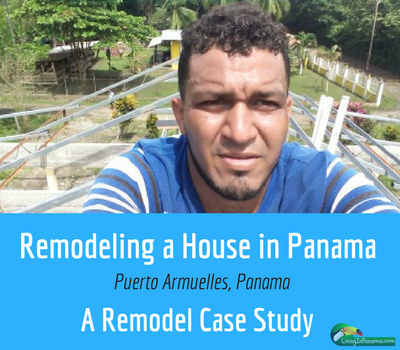
The house is nick-named “Casa Sombrero” because of its big sheltering roof.
It is on a corner lot in the Corazon de Jesus neighborhood, just north of downtown Puerto Armuelles. The house sits about 100 meters from the beach. While not as windy as a beachfront lot, there is still a good breeze when the onshore winds blow on warm afternoons.
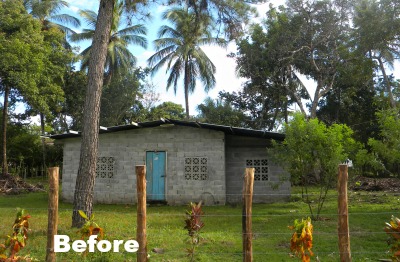
The original footprint of this humble concrete block house was 30'x 22' with two notches removed. Total floor area was about 600 square feet. It had 2 bedrooms, 1 bath, kitchen, and dining/living area.
As you can see by the photos of the original house, it was very basic house indeed. Just a concrete block cottage, with a tin roof, and very few, small window openings that were filled with ventilated cement blocks. Not surprisingly, the original house was hot and stuffy.
Our redesign, in collaboration with a local Panamanian architect, maintains the 2 bedroom, 1 bath of the original small house, but adds an additional 1500 square feet of breezy covered porch space, enclosed by ornamental ironwork.
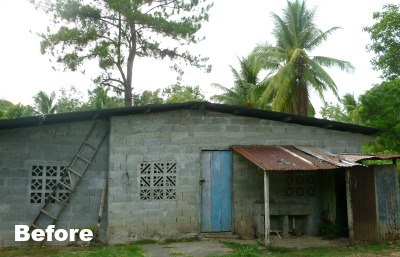
The open plan is intended to permit the ample porch areas of the house to serve as the primary day use areas. So that most of the events of daytime domestic life can take place within earshot of the sounds of ocean waves and the songbirds of Panama.
The original spaces have solid concrete block walls and large window openings.
This entire original area could be used as an “air conditioned zone.” Or, a smaller area, say just the bedrooms or bedroom, office and bathroom could be air conditioned by a single air conditioner.
The large outdoor porch/living area makes the house much more integrated into the outdoor environment. It is quite comfortable and dramatically reduces the energy requirement of running lots of air conditioning units. If the house had been redesigned as a typical northern home, extensive air conditionally would be required for most expats.
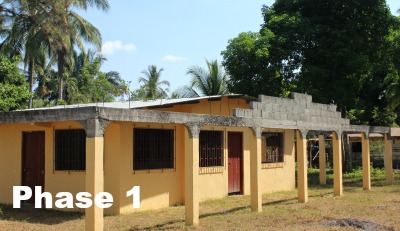
In the first phase of remodeling, we cut numerous new window openings, and enlarged the existing openings.
We also demolished a wall that had divided the kitchen and the dining area into 2 separate spaces.
Since the spaces were so tight, we thought that one big open plan for kitchen/dining /living was better than several smaller spaces. We added ironwork to the window openings, both for security and to give a sense of “completion” and enclosure.
Next, we asked our contractor to build a colonnade around the perimeter of the existing structure. This created wide porches on all sides of the house.
At its widest the porch is nearly 13 feet, and its narrowest about 7 feet. On top of these columns, spaced 9 feet apart, the contractor poured a concrete beam with gently radiused connections at the tops of the columns.
This is a look that we find quite pleasant, and which is quite common in Puerto Armuelles. Bluntly put, it is sort of a “poor man’s Spanish colonial”. It has the old world arches, but lacks the two-foot thick stone walls of Old Spain.
The house was rented to a Panamanian man in this Phase 1 condition for a couple of years. The man lived in the house, rent free, in exchange for maintaining the garden.
The truth is that up until a couple of years ago the real estate market in Puerto Armuelles was not as fast as the rest of Panama. Now our market has definitely begun to pick up. In fact, there were 2 families who were interested in buying Casa Sombrero at the same moment. We ended up selling it to a couple from British Columbia and their four young children.
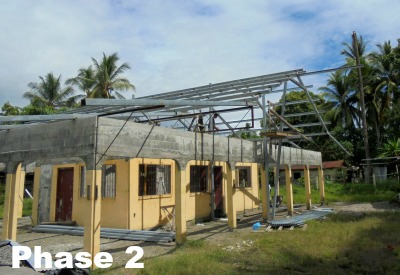
The new owners appear to be very comfortable building their own homes, which they have done before in British Columbia, including a home on the Queen Charlotte islands.
They hired our general contractor to raise the walls of the existing structure, pour a floor, and to install a new roof. From here, the client is going to take over as his own contractor, and supervise all of the ongoing finishes.
While this Canadian family works on their new home, they are staying in our house in Las Palmas. Since they have young
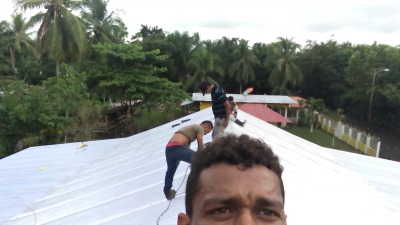
children, we offered them our house, so that they would have a “gentle landing” into their new life in the tropics. They are apparently quite capable, bilingual, and it appears that they are enjoying a successful remodel.
As you can see from the photos, the roof is on. The owner is working on site every day alongside the Panamanian contractor, and the project is advancing well. The new owner says that he hopes his family can move into their new home by Christmas.

Of course, not all of our clients are interested in, or capable of, being their own building contractor.
For this reason, we offer the option of having one of our Living In Panama House built for them, using the services of one of our licensed Panamanian contractors. We always oversee all our remodeling or Living In Panama House projects.
If have built or remodeled a home in Panama, please share your experiences in the comments below.
Recently, we have talked with a number of people who are interested in building tiny homes in Panama. If you have experience with tiny homes or if you would like to share any techniques for building in the tropics, please add them in comments.
Thank you.
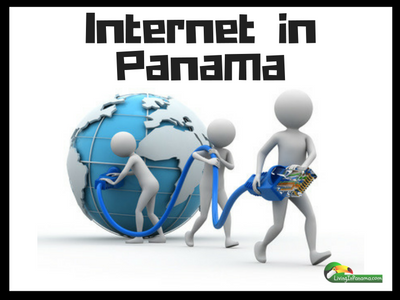
I'm not saying that internet in Panama will not be without its frustrations. It may stop for no apparent reason, you may pull your hair out while talking to, or trying to talk to, customer service, and then of course, the internet may be working fine, but you wouldn't know it because the electricity it out.
However, as you'd imagine, I use the internet all the time in Panama. Overall, while it is not lightening fast, it is more than adequate.
If you are in or near a city or town, it will be fairly easy to get internet. The more remote your location the harder it will be.
In the more developed parts of the country, like Panama City area, Colon and David, you will find high speed (for Panama) broadband cable internet and DSL.
In undeveloped, or older areas, then most likely you will be left with DSL as your fastest option. DSL can be fast, but its speed can fluctuate. In remote areas, the only option is satellite internet. Satellite internet can be very fast, but is more expensive.
At one time, the only Internet provider was Cable & Wireless. But since 2003 when the government opened up telecommunications to competition there have been a growing number of providers.
I asked a friend of ours to share her experiences with various internet companies in Panama. Specifically, in Puerto Armuelles, Panama. She has tried a few providers, while I have only used Cable & Wireless.
Our friend prefers to stay anonymous. I have edited her words slightly for clarity and added sub-headers.
Here is her experience with Internet in Panama.
I have used several Internet providers during my time in Puerto Armuelles.
Internet Activo
Currently I have Internet Activo and have been very satisfied with them and their service.
The only down side is they currently do not offer automatic deduction from a credit card for payment. So, I pay them every three months when I go to David. The other option would be to pay at one of the two banks where they offer a payment service of making the deposit and then providing proof of deposit.(Both banks are in Bugaba. But if I drive that far, I don’t see any sense in not just making a David run of it)
Planet Telecom
Planet Telecom was a personal nightmare for me on so many levels. They promised installation and equipment in a week – it took a month. I was at Andrea’s (an Internet place in downtown Puerto) for hours every day. (They knew not to set the timer on my computer!!) That was a pain because at the time I did not have my truck here.
When I was building my house, I wanted Plant Telecome to pre-wire my house. They sent someone out, finally, to do the pre-wiring. Because I had made an inquiry about the possibility of TV, as well as internet, they just assumed I wanted TV and installed that wiring as well.
I was charged for both the internet wiring and the TV wiring, as well as the travel and time to do the installation. The reality was that they were doing such a poor job that my worker, Jonathan, actually ran the wires! That is when I decided I would no longer do business with Planet Telecom!
Fidanque
I moved into my house and initially had Internet a company that is now called Fidanque. They were very good until they weren’t. I did like that they would automatically deduct the payment from the credit card I provided.
When they started the road expansion project, my Internet service was completely disrupted. I believe it was from interference from all the communications systems the road workers were using. At any rate they never could get the whole signal thing worked out so I had to move on.
Internet Activo (again)
Enter Internet Activo. They had no qualms about putting up an antenna that was high enough to block out the interference from the lower level interference. They are courteous, prompt, speak English and understand my payment schedule. I have been asking them to open a small account at Banco National, but so far no luck. I will ask them again when I go make the next 3 month payment. For some reason they believe that there is a $10,000.00 fee to set up automatic deductions from credit cards. There very well may be; I simply have no expertise in that area.
Cable Onda
Cable Onda has an excellent product and I had them for about a minute. (I still have their equipment on my roof).
The guy who signed me up spoke English. The guys who installed did not. After about a week, when I ran into a signal issue, I was dead in the water. No one anywhere in the company could speak English.
Right now, I am waiting for Cable Onda to finish laying all their fiber optic cable and will then I will switch over to them for phone and internet. They do have the best price – about $23.00 for 3meg of internet. Don’t know what it will be with telephone, but don’t think it will be that much more. They started marking their presence with a “deal” on satellite TV (all the blue dishes) so they would have some sort of customer base when they get the fiber optics done.
Cable & Wireless
Cable and Wireless has recently been bought out by someone else. They are unable to deliver 3 meg to Corazon de Jesus even though they say they can when they sign you up (enough theys for ya). Alexandra has them at her house – phone and internet – and the service is reasonably reliable. When there is an issue the repair guy is fairly prompt. They do have English speakers in their call center now so that does help with problems.
Internet Sticks or Dongle
I even tried one of those dongles and it was OK for checking email, but only while I was in the rental house. It never did work once I moved into my house.
(Note: you can buy these internet sticks, or traveling hotspots, from most internet and cell phone providers such as Claro and Movistar. They cost about $15 and the speed is slow. They can be useful for checking email and such in places without any internet.)
That is my Internet saga.
In another post, I (Betsy) will share my Cable & Wireless saga.
In May 2016, Cable & Wireless was purchased by Liberty Global. Hopefully, it will improve. Liberty Global is an American company, is in 30 countries and is the world's largest international TV and broadband company.
Here are some things to think about before choosing an Internet provider.
I would take their answers to these questions with a grain of salt, but it could give you a good indication of what it will be like to deal with them.
Important: Remember to check your Internet speed to ensure you are not paying for more than you are getting. Immediately downgrade so that you are paying for the speed you are getting, not the speed they promise you will get.
Updated March 16, 2017
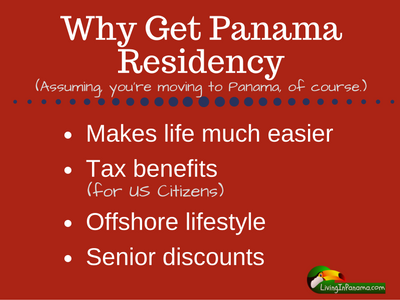
Americans may have more reasons to get a Panama residency than other foreigners, but every nationality benefits. (Scroll down for 3 American specific reasons)
As I said, a cedula is a Panama ID card. You can only apply for a cedula, after you become a Panama resident.
A cedula is forever. It is a document with a number specific to you. Like your social security number, it never changes.
Without a cedula, anything you do: getting a bank account, electricity, buying land, or even registering your car is done using your passport number. Unfortunately, every time you renew your passport you get a new passport number as well. Changing the passport number you have associated with almost everything in Panama is a nightmare and takes time.
More Cedula Perks
Get even more details about Panama cedulas in one of my older posts.
If you’re an American, you may have even more reasons to want be a Panama resident.
3 Reasons To Consider
Learn more about 4 types of Panama Residency Visas on my site.
March 2017 UPDATE: New Tourist visa rules make it impossible to be a Permanent Tourist in Panama. You must leave the country for at least 30 days before you can get another tourist visa.
Until March 6, 2017, many people lived in Panama as tourists for many years. But no longer!
You will need many documents to get residency: an FBI report, finger prints, birth certificates, medical examination reports, affidavits and more. It all must be certified, authenticated, notarized, stamped and gathered together and submitted, in person, in your presence. And some of those documents, like your FBI report, can expire and need to be done again if too much time passes before you are able to submit it.
There are 8 or 9 Panama residence visas. As I mention above, I have written about the 4 most common types of Panama residency visas.
You may want to hold off on getting your residency visa until you are sure you want to live in Panama on a long-term basis. The tourist visa gives you 180 days to check out Panama as you decide if it is a good fit.
Please let us know if we forgot to mention some of the benefits of having residency. Please comment below.
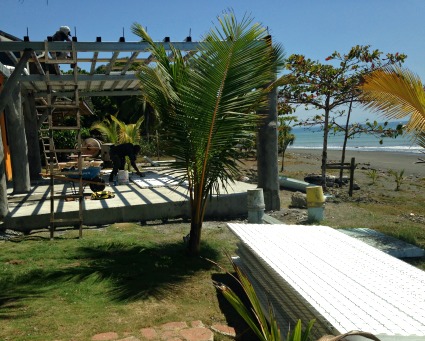
Given that, I was surprised that one of my favorite things to do as we traveled around Panama was to stop by construction sites and talk with other builders. I had fled the hustle and bustle of the building trade in Seattle only to discover, once again, how much I enjoy the fundamental beauty of human “dwellings” and how they are built. Apparently I made a good choice when I chose to become a designer/builder.
It doesn’t take long for one builder, chatting with another builder, in a new area, before the conversation winds its way around to the cost of materials, the cost of labor, the cost of land, to arrive at the potential profitability of being a builder in this new location.
Although I always prided myself on being more of an artisan design/builder than just a financially-motivated contractor, the profit potential in Panama is very seductive.
Early in our Panama travels we met a young builder and his girlfriend at Playa Cambutal. Playa Cambutal is out on the Azuero Peninsula, past Pedasi and Tonosi. They were both surfers and they loved this beautiful surf spot. The young man had borrowed $30,000 (as I recall) from his father who was a realtor somewhere in California. With this money, he and his girlfriend were able to buy a number of oceanfront farms, totaling over 2 miles of beachfront. Amazing!
We all know stories like this, and at first glance, one might say, “Wow! You guys are lucky. I guess we got here too late.” I remember my Dad telling stories about the farm he could have bought in Northern Virginia, a farm that later became Tyson’s Corner Mall.
There have always been great deals. And there will always be great deals. And we are all going to die some day. We still see amazing land deals in Panama.
About 10 years ago we spent some time investigating Pedasi and Tonosi, and other nearby locations. Yes, we discovered some amazing land deals. However, we decided that we were not interested in living so remotely, so far from services. And we had no interest in traveling to check in on any land we would buy in such a remote location.
This young couple (above) explained to us that they had to spend several hours, twice a week, driving to a small town, about 40 miles away, to do their basic shopping. For our own family, spending so many hours on the road, just sitting in the car, and burning gasoline, would not have fit our desired lifestyle. This was the in-the-car lifestyle we were trying to avoid by moving from Seattle. So we left the Azuero Peninsula and chose to live and invest in Puerto Armuelles. If you have read our site much, you will know we are very happy with our decision.
When I am asked if there are any “deals” left in Puerto Armuelles, I have to chuckle.
In truth, the big speculator class of investors arrived in Puerto 12 or 13 years ago. We got here 3 years after the miles of beachfront were sold to speculators from out of town. These same early investors continue to sit on some of the largest tracts of beachfront property in our area. I have no idea how they spend their days. But I am sure that they hardly ever think about our little beach town, unless they are looking at their investment portfolios.
A couple of these “big fish” are now offering schematic drawings of their future plans for these properties, but they haven't started to build yet. Or seemingly will in the near future. Meanwhile, a smaller class of builders, folks like us, is beginning to develop and build.
Yes, there are deals still to be had here. But you will not find the best deals advertised on the internet. You will find them by being here in Puerto.
You need to look around. Decide on your favorite locations and start talking with people. You will start to hear about some stellar deals.
For instance, if you shop, you can still pick up a house, a block from the water, for only $11,000 and a buildable lot for as low as 3 to $5,000.
Puerto Armuelles is a beach town of 25,000 residents, give or take.
It has many good properties and existing buildings, that with a skillful touch can still be resold for a substantial profit.
We want to encourage designers and builders to come check out Puerto Armuelles. To discover if there are any potential projects that suit them in our town. If so, not only will you have a great project, but you can step out of the stressful lifestyle of being a builder, contractor, or designer up north.
If you have experience in alternative energy housing, cooling, and transportation, even better. That is an untapped market here.
There is plenty of room for competitors in our market. Puerto Armuelles does have a few good builders, but we definitely need more motivated and skilled investor builders to provide housing for the growing influx of expat retirees. More good builders will just bring a greater diversity of expats and Panamanians to enjoy the lifestyle that Puerto has to offer.
Small-scale projects are definitely in demand. We recently sold a couple of our own projects. We did not make ten, or even five times our initial investment, but we have done well enough to carry us forward. Plus we have had a good family adventure and enjoyed our time doing it. And we have also slowly evolved our guiding design principles for building in our area. We are eager to continue to buy, to build and to sell.
We are excited by the uptick in the housing sales market. This enables us and others to design and build in a manner that inspires us, and that we think will be useful to new expat residents of Puerto Armuelles.
Our friend Victor describes life in Puerto Armuelles as being similar to that of Hawaii, or Southern California of 50 years ago.
You may find Puerto Armuelles is a more relaxed, and probably a more profitable building environment. And you won't have the stiff competition from other builders.
The broadest market niche by far available to expats in the construction field is that of “investor/builder”. You don't need a work permit to work on your own property, even if your intent is to sell it.
However, for the last few years, Panama has made getting a work permit much easier. This is especially true if you obtain the easy-to-get, Friendly Nations visa. That permanent resident visa was designed as a stepping stone to a work permit.
If you are a builder looking for a change in lifestyle, we invite you to check out our town.
For the builder who loves a beach town lifestyle, I would say that Puerto Armuelles is similar to Puerto Vallarta 50 years ago. It is a relaxed, maritime environment. And it probably won’t be like this forever.
Related Reading
You may be interested in reading my articles about building. I have given my 2 cents on
We have also written about these related items: